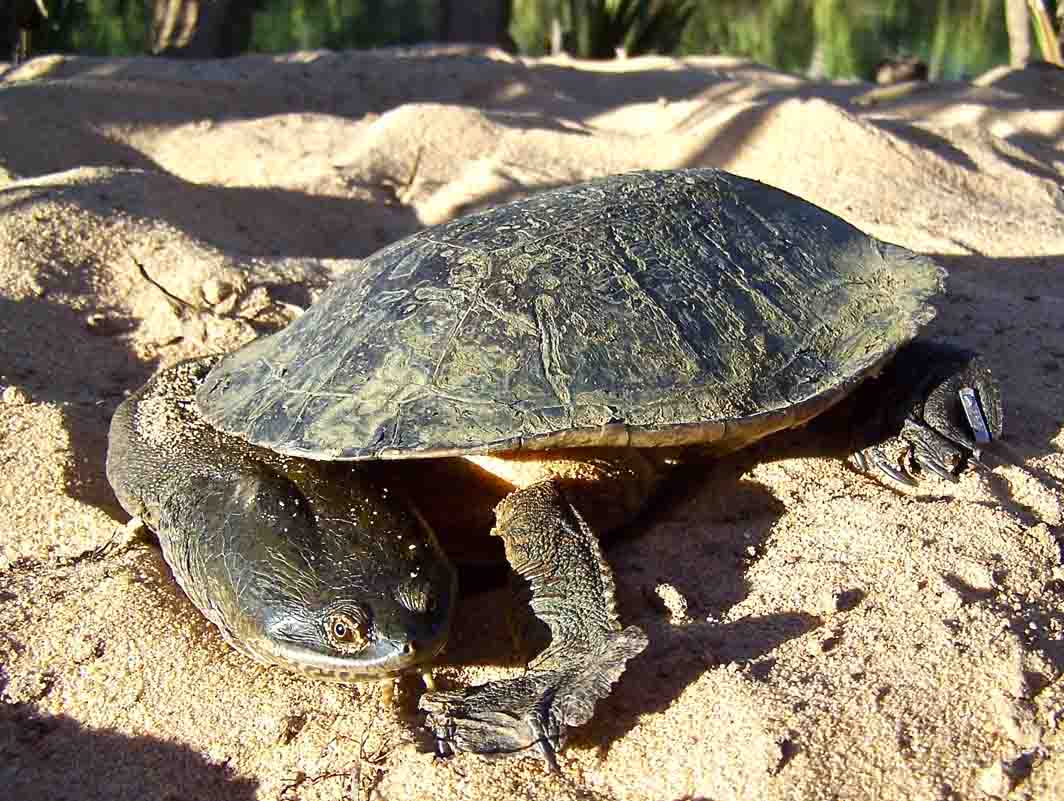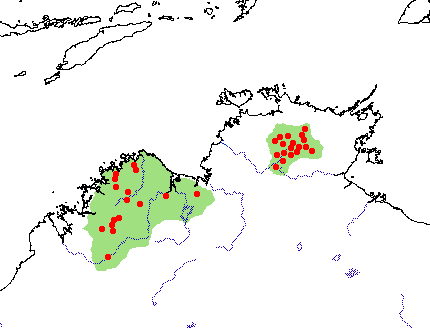Chelodina burrungandjii, 056
Chelodina burrungandjii Thomson, Kennett, and Georges 2000 –
Sandstone Snake-Necked Turtle
Scott Thomson1,4, Rod Kennett2, Anton Tucker1,3, Nancy N. FitzSimmons1,
Phillipa Featherston1, Erika A. Alacs1, and Arthur Georges1
1Institute for Applied Ecology, University of Canberra, ACT 2601, Australia
[[email protected]; [email protected];
[email protected]; [email protected]];
2North Australian Indigenous Land and Sea Management Alliance (NAILSMA),
Charles Darwin University, Darwin NT 0909, Australia [[email protected]];
3Sea Turtle Conservation and Research, Mote Marine Laboratory,
1600 Ken Thompson Parkway, Sarasota, Florida 34236 USA [[email protected]];
4Present Address: 700 Holly Street, Warren, Pennsylvania 16365 USA [[email protected]]
Summary. – Chelodina (Macrochelodina) burrungandjii, the Sandstone Snake-necked Turtle (Family Chelidae), is a medium-sized turtle (carapace length to 316 mm) that occupies the sandstone plateaus and associated escarpments and plunge pools of Arnhem Land and the Kimberley Region of tropical northern Australia. First collected by scientists some 20 years ago, research on the species has been hampered by its isolation—its range is sparsely inhabited, rugged sandstone country. The species can be diagnosed by its broad and flattened skull and by the contact of the vomer and the pterygoids and shows marked differences in life history and ecology from its closest relative, Chelodina rugosa. These two species are found together in the rivers that drain the Arnhem Land Plateau, but are broadly parapatric, with C. burrungandjii occupying the streams and associated pools of the uplands and C. rugosa occupying the floodplains and billabongs of the lowlands. Where their distributions come in contact in the Arnhem Land region, there is evidence of hybridization and widespread introgression. This may also occur near the northern border of Western Australia and the Northern Territory but does not occur in the Kimberley Region, which is outside the range of C. rugosa. It is not known whether there will be adverse impacts on C. burrungandjii from the recent invasion of its range by the exotic and toxic cane toad, Rhinella marina, but its congener C. rugosa is reasonably susceptible to the toxins when administered experimentally. Chelodina burrungandjii is harvested by Aboriginal peoples throughout its range to varying degrees. The species is not considered to be threatened, though populations of this species are small, isolated, and potentially subject to risk from overharvest or collecting for trade, or toxicity from cane toad ingestion.
Distribution. – Australia. Distributed on the sandstone plateaus and associated escarpments and plunge pools of Arnhem Land, Northern Territory, and disjunctly in the Kimberley Region of northern Western Australia.
Synonymy. – Chelodina burrungandjii Thomson, Kennett, and Georges 2000, Macrochelodina burrungandjii, Chelodina (Macrochelodina) burrungandjii, Macrochelodina walloyarrina McCord and Joseph-Ouni 2007.
Subspecies. – None currently recognized.
Status. – IUCN 2011 Red List: Not listed; CITES: Not listed; Australian EPBC Act: Not Listed; Northern Territory PWC Act: Not listed.
Citation:
Thomson, S., Kennett, R., Tucker, A., FitzSimmons, N.N., Featherston, P., Alacs, E.A., and Georges, A. 2011. Chelodina burrungandjii Thomson, Kennett, and Georges 2000 – Sandstone Snake-Necked Turtle. In: Rhodin, A.G.J., Pritchard, P.C.H., van Dijk, P.P., Saumure, R.A., Buhlmann, K.A., Iverson, J.B., and Mittermeier, R.A. (Eds.). Conservation Biology of Freshwater Turtles and Tortoises: A Compilation Project of the IUCN/SSC Tortoise and Freshwater Turtle Specialist Group. Chelonian Research Monographs No. 5, pp. 056.1–056.7, doi:10.3854/crm.5.056.burrungandjii.v1.2011, //iucn-tftsg.org/cbftt/.
(Adobe Acrobat 6.0 or later required)

A female Chelodina burrungandjii from the Kimberley Region of Western Australia. Note the extremely broad, flattened head that distinguishes the species from C. rugosa.
Photo by Nancy FitzSimmons.
Distribution:

Distribution of Chelodina burrungandjii in northern Australia; the Arnhem Plateau is the disjunct area to the northeast, the Kimberley Region is to the southwest. Red dots = museum and literature occurrence records of native populations based on Iverson (1992) (partim, as C. rugosa), Thomson et al. (2000), and more recent and authors’ data; green shading = projected distribution based on GIS-defined hydrologic unit compartments (HUCs) constructed around verified localities and then adding HUCs that connect known point localities in the same watershed or physiographic region, and similar habitats and elevations as verified HUCs (Buhlmann et al. 2009), and adjusted based on authors’ data.








